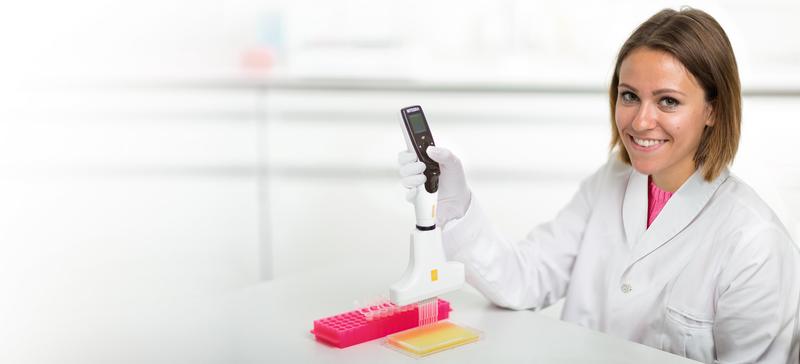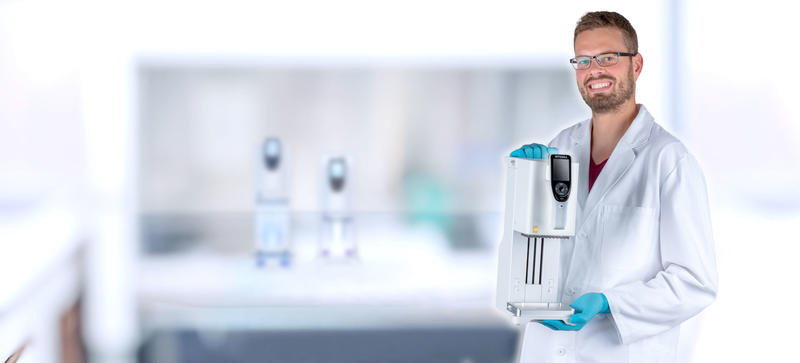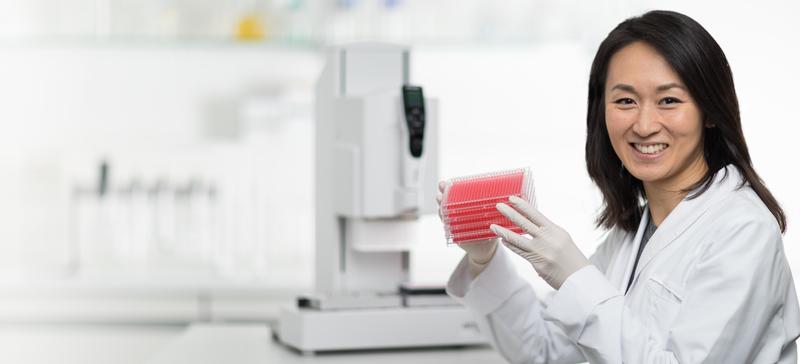-
Automation of the MACHEREY-NAGEL NucleoSpin®96 Tissue Kit on the ASSIST PLUS pipetting robot
Obtain high quality tissue DNA by pairing the MACHEREY-NAGEL NucleoSpin 96 Tissue Kit with the ASSIST PLUS pipetting robot
MACHEREY-NAGEL’s NucleoSpin®96 nucleic acid extraction and purification kits are known for producing high quality nucleic acids. The NucleoSpin 96 Tissue kit is designed for rapid purification of high molecular weight genomic DNA from tissue samples, such as mouse and rat tails, organ tissue, and animal or bacterial cells. The purified DNA can be used directly for a variety of downstream applications, including PCR, Southern blotting, genotyping, NGS or any kind of enzymatic reaction. The NucleoSpin 96 Tissue kit is convenient for high-throughput DNA extractions, but the many pipetting steps required in the manual processing of samples are tiring for users and introduce the opportunity for pipetting errors at each step. Performing the assay on the ASSIST PLUS pipetting robot eliminates the possibility of pipetting errors and provides straightforward semi-automated sample extraction, eliminating the possibility of pipetting errors and reducing the strain of repetitive pipetting.
-
Table of contents
MACHEREY-NAGEL’s NucleoSpin®96 nucleic acid extraction and purification kits are known for producing high quality nucleic acids. The NucleoSpin 96 Tissue kit is designed for rapid purification of high molecular weight genomic DNA from tissue samples, such as mouse and rat tails, organ tissue, and animal or bacterial cells. The purified DNA can be used directly for a variety of downstream applications, including PCR, Southern blotting, genotyping, NGS or any kind of enzymatic reaction. The NucleoSpin 96 Tissue kit is convenient for high-throughput DNA extractions, but the many pipetting steps required in the manual processing of samples are tiring for users and introduce the opportunity for pipetting errors at each step. Performing the assay on the ASSIST PLUS pipetting robot eliminates the possibility of pipetting errors and provides straightforward semi-automated sample extraction, eliminating the possibility of pipetting errors and reducing the strain of repetitive pipetting.
Key benefits
- 96 samples can be extracted in less than 1 hour by processing 12 samples in parallel. Programs can be modified if extraction of fewer samples is required.
- Automation of the liquid handling steps of the DNA purification workflow with the ASSIST PLUS pipetting robot frees up time for the user and increases reproducibility.
- Manual interventions are limited to operating the on/off button of the vacuum, reagent reservoir exchange and placement of the elution plate within the vacuum manifold. Instructions for these steps are provided on the pipette’s bright screen, ensuring the user does not lose track of the process.
- The benefit of the NucleoSpin 96 Tissue kit over other options is the inclusion of a specially designed wash plate, inserted into the manifold beneath the binding plate. The wash plate prevents cross-contamination of samples during the vacuum steps.
Overview: How to automate the NucleoSpin 96 Tissue kit
This protocol describes the automation of the pipetting steps of the MACHEREY-NAGEL NucleoSpin 96 Tissue kit are automated on the ASSIST PLUS pipetting robot. All liquids are transferred automatically, with manual interventions only required for turning the vacuum on and off, loading reagent reservoir 1 and 2, and preparing the elution plate. The ASSIST PLUS operates a 12 channel VIAFLO 1250 μl electronic pipette with 1250 μl Sterile, Filter GRIPTIPS®.
Before starting, the indicated volume of Proteinase Buffer PB should be added to the lyophilized Proteinase K (see MACHEREY-NAGEL protocol) and ethanol (96-100 %) should be added to the Wash Buffer B5 Concentrate.
Tissue samples are prepared following MACHEREY-NAGEL's recommendations: mouse tails should be cut into 0.5 cm pieces, tissue samples should not exceed 20 mg, and cultured cells and bacteria should not exceed 106 cells.
25 µl Proteinase K and 180 µl Lysis Buffer T1 should be added to the culture plate containing the samples. The plate should be shaken for 10-15 min, then centrifuged and incubated at 56 °C for at least 6 hours, until the samples are completely lysed.
Downloads: App note and protocols for the Tissue Kit on the ASSIST PLUS pipetting robot
Here you can download the complete protocols and reports used in this application and use them on your ASSIST PLUS. The protocol can be customized with the VIALAB software.
Experiment set-up
Deck Position A: 8 row reagent reservoir holding kit buffers.
Deck Position B: 96 well, deep well plate.
Deck Position C: NucleoVac 96 vacuum manifold with NucleoSpin Tissue Binding Plate and MN Wash Plate.
IMPORTANT: Align the vacuum manifold before each run (see Appendix).
For the initial set-up, assemble the manifold as shown in Figure 2, with the NucleoSpin Tissue Binding Plate on top of the manifold and the MN Wash Plate inside the manifold.
Step-by-step procedure:
Overview of the steps:
- Binding
- Washing
- Drying
- Elution
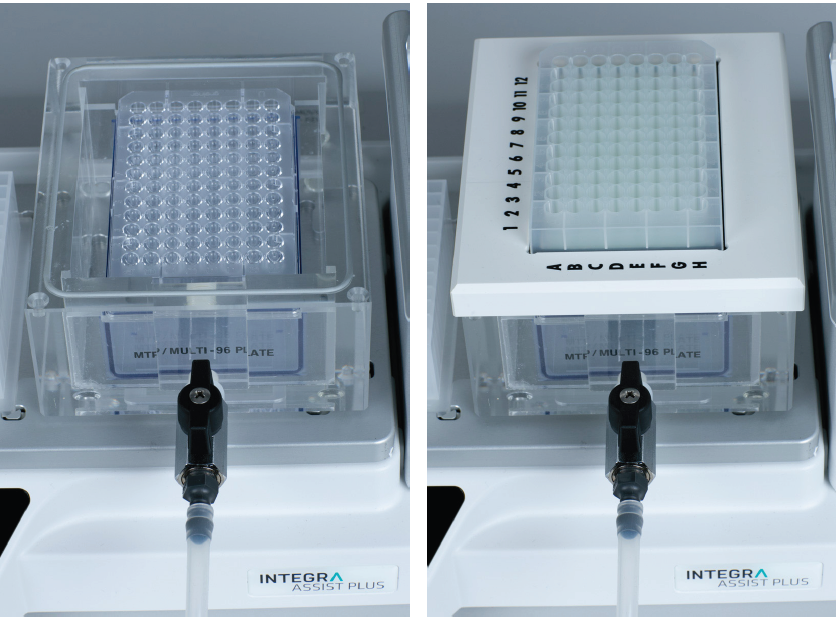
1. Binding
Bind the tissue DNA to the silica membrane.
After the tissue lysis step, the ASSIST PLUS pipetting robot transfers 200 µl Binding Buffer BQ1 from row A of the reservoir and 200 µl 96-100 % ethanol from row B to each well of the culture plate.
The program directly continues with a mixing step, then the pipette transfers the lysate to the NucleoSpin Tissue Binding Plate (green rings) placed on the vacuum manifold. The pipette prompts the user of a 1 minute incubation step, then prompts the operator to turn on the vacuum pump. Apply a vacuum of -0.2 bar for 5 minutes. Release the vacuum as indicated by the pipette once all the lysates have passed through the wells of the binding plate.
TIP:
- An air gap has been set at the end of the aspiration to prevent cross contamination.
2. Washing
Wash the silica membrane in three steps.
The ASSIST PLUS pipetting robot adds 600 µl Wash Buffer BW to each well in three repeat dispense steps. Apply a vacuum of -0.2 bar for 5 minutes. Release the vacuum. The pipette prompts the user to exchange buffer reservoir 1 with buffer reservoir 2. The ASSIST PLUS transfers 900 µl Wash Buffer B5 to each well for a second wash step. Apply the vacuum using the same conditions as before, release it and allow the pipette to transfer 900 µl Wash Buffer B5 to each well for the third wash step. Apply the vacuum as before for 5 minutes, then release it.
3. Drying
Dry the silica membrane
Following the final wash step with Wash Buffer B5, remove the NucleoSpin Tissue Binding Plate from the vacuum manifold. Tap the plate on a clean paper towel to remove residual ethanol-containing wash buffer. Remove the wash plate and waste plate from the vacuum manifold. Set the vacuum to -0.6 bar. Insert the NucleoSpin Tissue Binding Plate into the manifold lid, close the manifold and run the vacuum for 10 minutes to thoroughly dry the plate. Press run to activate the timer. An audible beep will occur at the end of the incubation. Release the vacuum.
4. Elution
Elute the DNA
The pipette prompts the user to exchange buffer reservoir 2 with buffer reservoir 1. Remove the lid of the vacuum manifold and insert the U-bottom Elution Plate. Replace the lid of the manifold with the NucleoSpin Tissue Binding Plate. Set the vacuum to -0.5 bar. Press run to activate the automated addition of 100 µl Elution Buffer BE to the NucleoSpin Tissue Binding Plate. Follow the prompts on the screen to incubate the plate for 3 minutes, then apply a vacuum for 2 minutes, releasing the DNA from the binding plate into the Elution Plate.
TIP:
- Elution buffer volume may be customized to meet the needs of individual users.
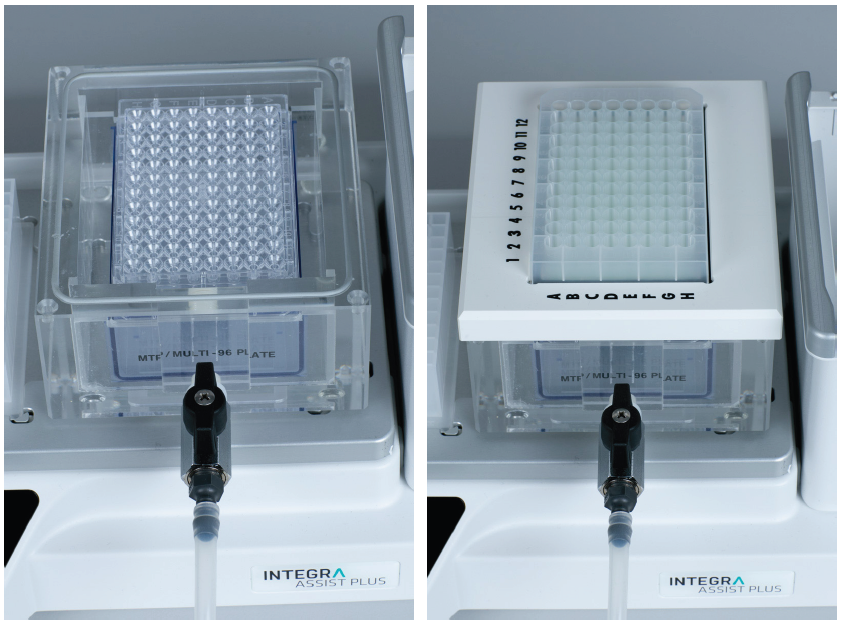
Results
The validation data shows high quality, highly pure genomic DNA obtained from spleen and HeLa cells using the ASSIST PLUS pipetting robot.
Remark
Partial plates:
Programs can be adapted to a different number of samples at any time, giving laboratories total flexibility to meet current and future demands.
Conclusion
- Automation of the MACHEREY-NAGEL NucleoSpin 96 Tissue kit can be easily achieved on the ASSIST PLUS pipetting robot equipped with a 12 channel VIAFLO electronic pipette.
- The NucleoSpin 96 Tissue kit yields high quality genomic DNA. Automation of the protocol eliminates inconsistent pipetting and user errors.
- The DNA extraction protocol is a single VIALAB program. Users can customize any step in the program using VIALAB software, or with support of INTEGRA representatives.
- Thanks to its compact footprint, the ASSIST PLUS pipetting robot can be placed in laminar flow cabinets, protecting samples from contamination.
Appendix: Performing the initial deck set-up
Make sure that the outlet of the vacuum manifold (Position C) is positioned towards the user so that the tower of the pipetting robot can move freely along the x-axis (Figure 1).
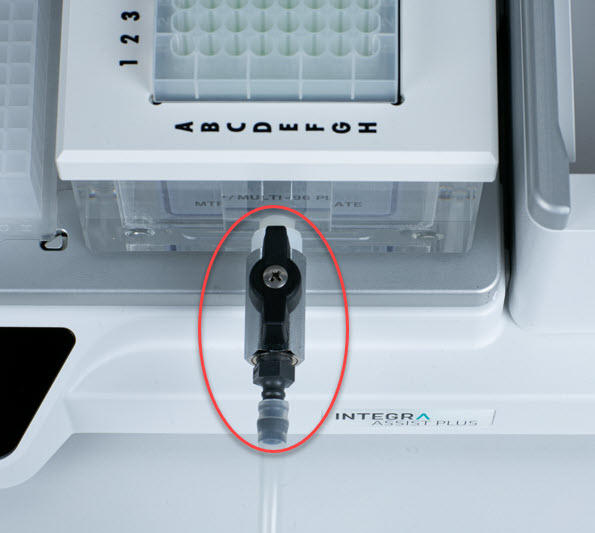
Place the manifold on the ASSIST PLUS deck next to the waste bin. After adjusting the position of the manifold for the first time, we recommend marking its position on the deck (see example in Figure 2). Thereafter, you simply have to align the vacuum manifold with the marks placed on the ASSIST PLUS.

To check the position of the well plate on top of the vacuum manifold, manually attach tips to the pipette. Use the touch panel keys to move the pipetting arm of the ASSIST PLUS and to control the tip position. First, select ‘ASSIST PLUS’ under the main menu of the pipette, then ‘VIALAB Programs’ and ‘MN Tissue DNA’. Go to ‘Height Adjust’, select ‘4 Transfer’ and then choose ‘Height 1/1’ under ‘Target’ using the left arrow. Confirm by pressing the ‘Start’ key on the ASSIST PLUS. The ASSIST PLUS moves to the chosen wells. Check the position of the vacuum manifold. The pipette tips should be in the middle of the wells. If necessary, manually adjust the position of the vacuum manifold on the deck. Press the back button on the pipette to exit the ‘Height Adjust’ menu and discard the tips manually. Continue with the protocol set-up.
Ask our expert. Leave a comment!
Write us if you have any questions regarding the application note or one of our instruments.
Any questions? I'm happy to help!
Instruments and accessories
ASSIST PLUS, Pipetting Robot
INTEGRA has developed the ASSIST PLUS pipetting robot to streamline routine pipetting tasks at an affordable price. Using INTEGRA electronic multichannel pipettes, the system:
- automates pipetting tasks,
- eliminates physical strain and
- ensures superior reproducibility and
- error free pipetting.
Part No. 4505
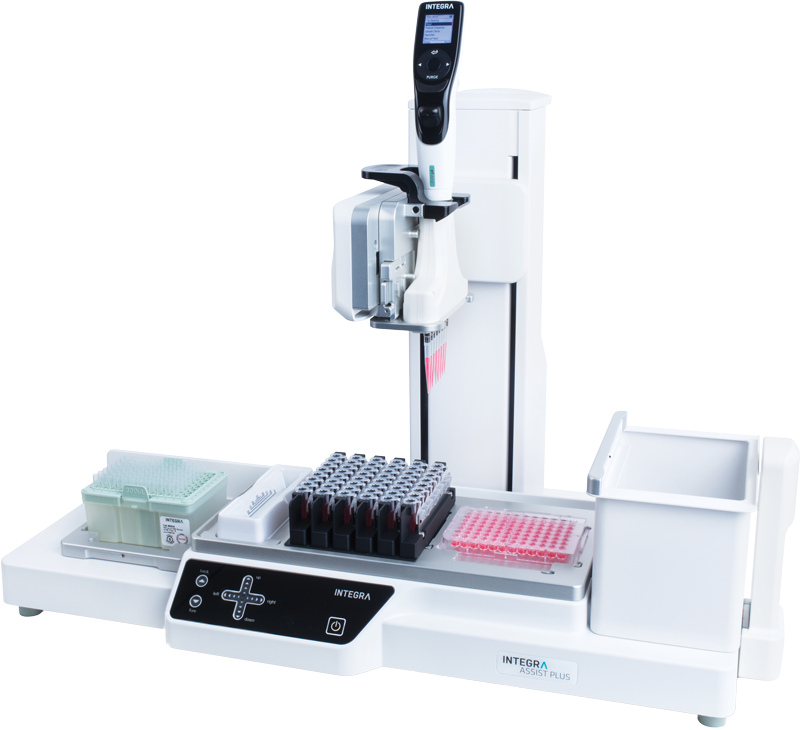
VIAFLO 12 channel, 1250 µl, electronic pipette
The Touch Wheel is a quick and ergonomic way to modify pipetting parameters. Instead of repeatedly pushing buttons or twisting fingers to modify volumes, you simply slide your finger over the wheel.
The full color screen provides full text menus (in multiple languages) and displays pipetting protocols without abbreviations, making VIAFLO pipettes particularly easy to understand and intuitive to use.
Part No. 4634
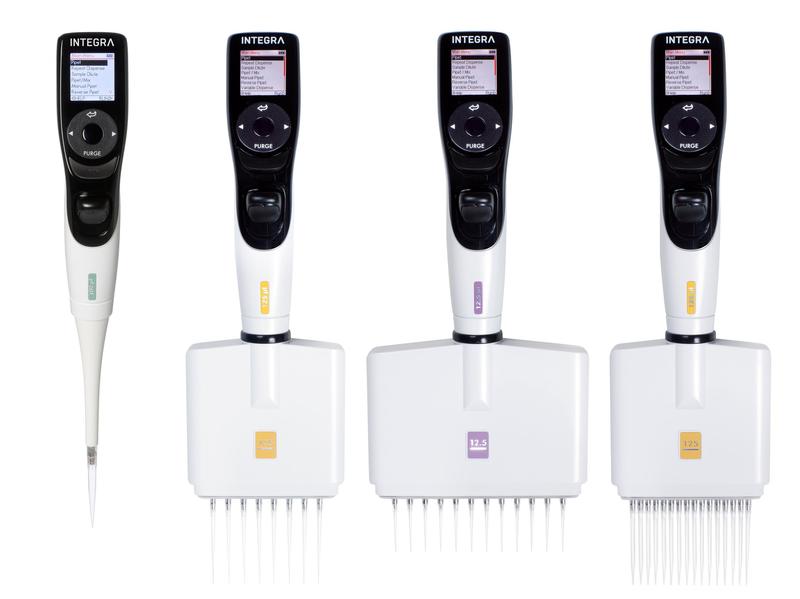
Communication module for INTEGRA electronic pipettes
For pairing INTEGRA electronic pipettes with the ASSIST PLUS.
Part-Nr. 4221
GRIPTIPS®, 1250 µl, Sterile
GRIPTIPS® pipette tips perfectly match the multi-lobe tip fitting, snapping firmly on during loading. This guarantees a perfect seal on every tip, preventing them from loosening, leaking or completely falling off. All tips are precisely aligned horizontally, enabling accurate touch-offs, even when pipetting with 384 tips.
Part No. 6445
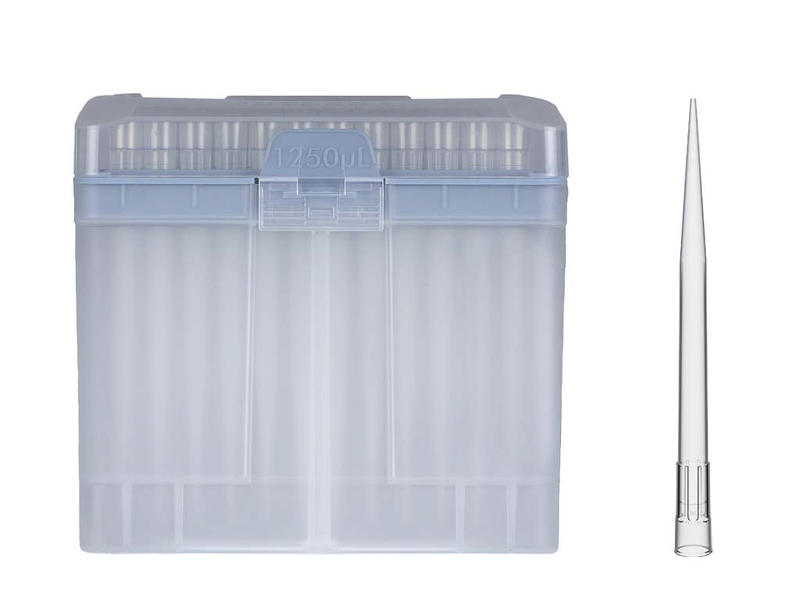
8 Row Polypropylene Reservoirs (6372)
The polypropylene design improves the reservoirs chemical compatibility and also allows the reservoirs to be autoclaved.
- Reagent reservoirs for 96 well plates
- Pyramid bottom
- Each row holds 32 ml
Part No. 6372
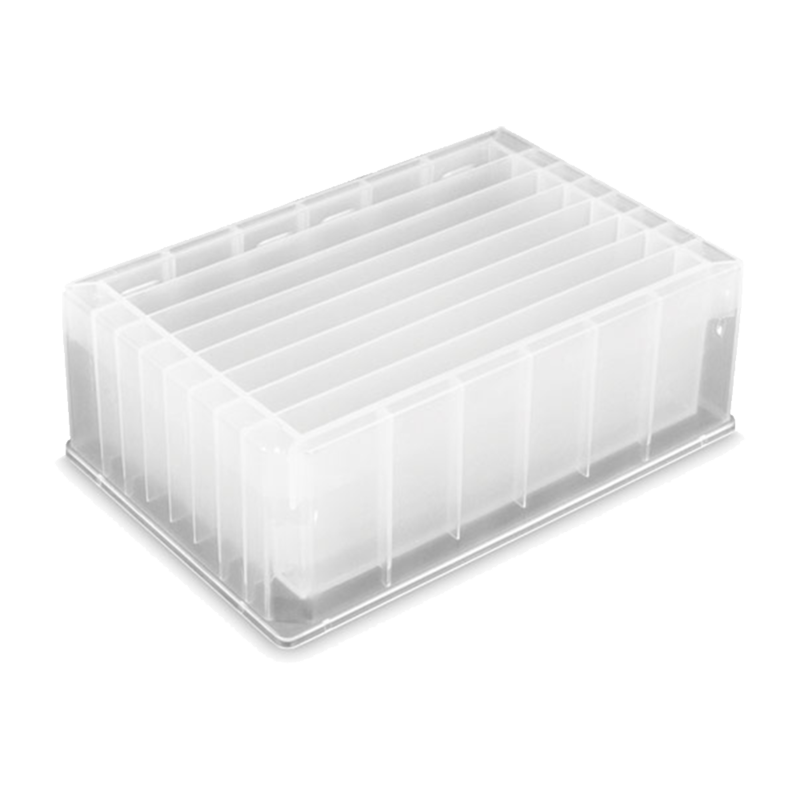
MACHEREY‑NAGEL: NucleoSpin 96 Tissue
Allround kit for purification of DNA from a broad range of samples in proven 96‑well plate format.
Source: Website MACHEREY-NAGEL
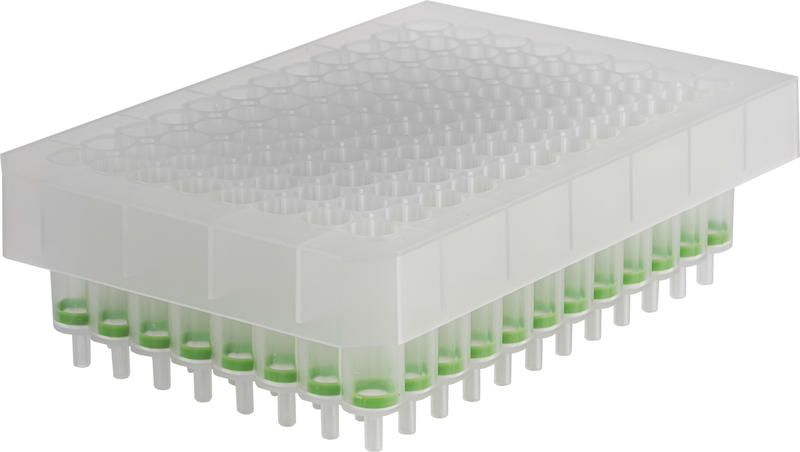
MACHEREY‑NAGEL: NucleoVac 96 Vacuum Manifold
Vacuum manifold consists of manifold base and lid, a spacer set, and two waste containers.
Source: Website MACHEREY-NAGEL
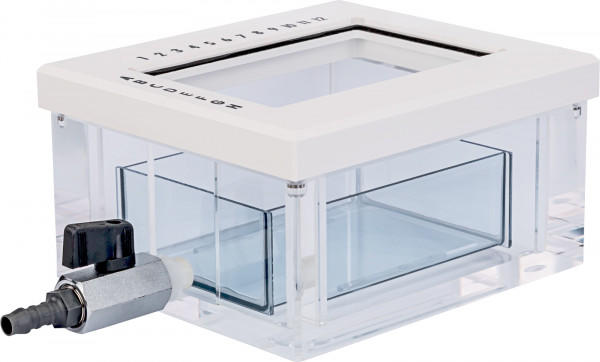
VACUUBRAND: Vacuum Pump
Chemistry-design diaphragm pumps are an excellent solution for continuous, oil-free pumping of corrosive gases and vapors.
Source: Website VACUUBRAND
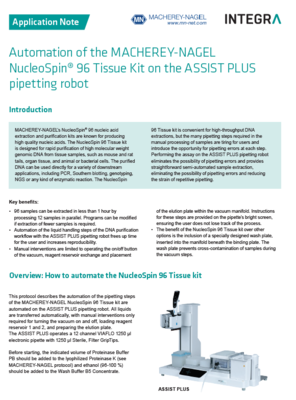
Download
Download App Note as PDF
DownloadAutomation of the MACHEREY-NAGEL NucleoSpin®96 Tissue Kit on the ASSIST PLUS pipetting robotCustomer’s voice
Assist Plus is a must-have system in the modern molecular biology laboratory
When talking about efficiency and automation, the use of this system in modern laboratories must be taken into account. Apart from the exceptional quality of its design, this equipment offers all the flexibility and precision necessary to carry out dissimilar and complex pipetting tasks in the laboratory or in industry. It is really a reliable and efficient "companion"! Thank you!

